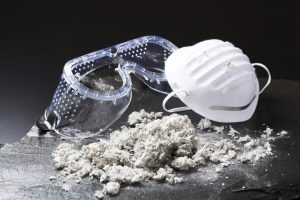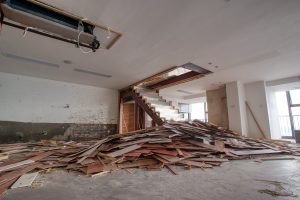Commercial buildings face unique challenges when it comes to environmental safety.
Unlike residential properties, these sites often contain a wide variety of hazardous materials, including asbestos and lead, petroleum products, industrial chemicals, and biological hazards.
Left unmanaged, these substances can harm employees, tenants, and the surrounding community, while also putting businesses at risk of steep regulatory fines.
That’s where hazardous waste removal contractors like Environmental Demolition Group (EDG) come in.
Our certified team specializes in hazardous waste removal in buildings, providing compliant, turnkey solutions for offices, warehouses, healthcare facilities, schools, and industrial properties.
We don’t just remove contaminants. We restore your property to safe, modern standards while safeguarding the people who rely on it. Ready to learn more?
Understanding Hazardous Waste in Commercial Buildings
Hazardous materials can be hidden in almost every corner of a commercial property. Some remain from outdated construction methods, while others accumulate over years of daily operations.
Left unchecked, these materials can compromise indoor air quality, weaken structural integrity, and even put lives at risk.
That’s why hazardous waste removal is critical to keep buildings safe and compliant.
Here are some of the most common hazardous materials found in commercial spaces:
- Asbestos-containing materials: Once considered a “miracle material” for insulation, tiles, and flooring, asbestos is now recognized as a severe respiratory hazard.
Disturbing asbestos during renovations without professional containment can release dangerous fibers into the air. - Lead-based paint and coatings: Frequently used in buildings before 1978, lead dust can spread during remodeling or even routine maintenance. Long-term exposure may lead to neurological damage, particularly in children, making the removal of hazardous materials in buildings a public health priority.
- Mold and microbial growth: Moisture from leaks, poor ventilation, or high humidity can foster mold colonies behind walls and under flooring. Beyond musty odors, mold exposure can cause respiratory issues and trigger asthma, posing risks for employees and tenants.
- Mercury: Outdated thermostats, fluorescent lighting, and certain lab equipment often contain mercury. Even small amounts can contaminate indoor environments, requiring specialized cleanup procedures.
- Industrial chemicals and solvents: Commercial buildings often store cleaning agents, degreasers, and other chemicals in maintenance rooms. Spills, leaks, or improper storage can create fire hazards and toxic exposure risks.
- Petroleum products and oils: Warehouses and facilities with mechanical equipment may have old tanks, drums, or spills that leach into the flooring or soil. Left unaddressed, these contaminants can spread quickly and cause costly environmental damage.
- Mining and construction residues: Heavy metals, contaminated fill, or structural materials from prior site use may still be present under foundations or within support pilings.
- Biological hazards: Abandoned buildings and older structures often contain animal droppings, carcasses, or other biological waste. These hazards can carry bacteria, viruses, and allergens that endanger both occupants and cleanup crews.
- Universal wastes: Common yet regulated items, such as fluorescent lamps, batteries, and electronic waste, may seem harmless, but improper disposal can release lead, mercury, or other toxins into the environment.
Hazardous waste isn’t just a facilities issue— it’s a business continuity and reputation issue. Environmental Demo Group helps building owners and managers safeguard both.

The EDG Hazardous Waste Removal Process
We ensure precision from start to finish with a complete plan you can trust. Our hazardous material waste removal process includes the following:
1. Site Assessment & Testing
We begin with a comprehensive inspection of your building to identify all hazardous substances. Using advanced testing methods, we pinpoint asbestos, lead, mold, mercury, and other contaminants.
2. Containment & Safety Controls
Before removal begins, we isolate affected areas to prevent cross-contamination. Negative air systems, sealed enclosures, and PPE protect both workers and building occupants.
3. Removal & Transportation
Our teams carefully remove hazardous materials using OSHA-approved methods. All waste is packaged, labeled, and transported in compliance with EPA hazardous waste regulations.
4. Disposal at Licensed Facilities
Hazardous materials must be disposed of at certified facilities. We maintain relationships with approved disposal sites to guarantee safe handling.
5. Asbestos & Lead: Controlled, Compliant Removal
Our team follows OSHA- and EPA-aligned practices for asbestos and lead abatement. Asbestos is wetted during removal, double-bagged, or kept wet until sealed, and then sent to licensed facilities for disposal.
For lead-based coatings, we use methods that minimize dust (often chemical stripping) and seal all waste for specialized disposal.
6. Site Remediation & Restoration
After removal, we restore affected areas: repairing, cleaning, and preparing spaces for safe re-occupancy or continued renovation.
7. Documentation & Peace of Mind
What sets EDG apart is our attention to detail and commitment to your peace of mind. At the end of every project, we provide a clean letter certifying your site is free of hazardous waste.
Along with that, you’ll receive manifests and disposal records detailing:
What materials were removed
When and how they were removed
Where they were taken for disposal

Where Hazardous Waste Removal Is Needed
Commercial buildings span a variety of sectors, each with its own environmental challenges. That’s why we serve a range of industries, including:
- Healthcare facilities: Hospitals, labs, and clinics with chemical and biological waste
- Office complexes: Older buildings with asbestos insulation and lead paint
- Schools & universities: Facilities that often house outdated building materials
- Manufacturing plants & warehouses: Sites with petroleum products, solvents, and heavy metals
- Retail & hospitality properties: Ensuring customer-facing environments meet health standards
Choosing the Right Hazardous Waste Removal Contractors
Not all contractors are created equal! Here’s what sets EDG apart:
- Proven Track Record: Decades of hazardous waste and demolition experience
- OSHA & EPA Certifications: Verified compliance with safety and environmental laws
- All-in-One Approach: From site assessment to disposal documentation, every detail is handled
- Customer-First Philosophy – As we say: You’re our boss. We deliver solutions tailored to your needs
- Respect for History & Property: We don’t just clean up; we honor the history of the structures we work on
Tip: When selecting environmental remediation contractors, look for a team that combines technical expertise with a customer-first culture to deliver safe, efficient results.

Beyond Hazardous Waste: Full Environmental Remediation
Hazardous waste removal often goes hand in hand with other environmental services.
We provide a complete suite of solutions for commercial buildings, eliminating the need to hire multiple contractors. These services include:
Asbestos Abatement
Removing asbestos safely from insulation, flooring, and ceilings
Lead Abatement
Eliminating toxic lead-based paints and coatings
Mold Remediation
Restoring healthy indoor air quality
Selective Demolition
Targeted demolition that isolates hazardous areas
Other Specialized Services
Including dry ice blasting and fire damage restoration
Compliance: What Building Owners Should Know
According to the EPA, businesses that generate hazardous waste must meet strict requirements for identification, labeling, storage, and disposal.
Compliance considerations include:
- Waste Classification: Determining whether materials are hazardous under federal law
- Storage Standards: Using proper containers, labeling, and secondary containment
- Transport Regulations: Ensuring only certified haulers manage the material
- Recordkeeping: Maintaining manifests, reports, and disposal certificates
The Risks of Ignoring Hazardous Waste
Some building owners assume that ignoring or covering up hazardous materials will save money. In reality, this approach leads to:
- Tenant and employee lawsuits for exposure to asbestos, mold, or chemicals
- Costly shutdowns or loss of occupancy permits until hazards are addressed
- Regulatory fines for improper storage or disposal
- Environmental contamination that spreads beyond the property line

Partner With EDG for Safe Hazardous Waste Removal
Your building deserves more than a quick cleanup. It deserves a team of hazardous waste removal contractors committed to safety, compliance, and community protection.
Ready to protect your building and your people? Request a Proposal and let EDG’s hazardous waste removal contractors handle the hard work for you!




